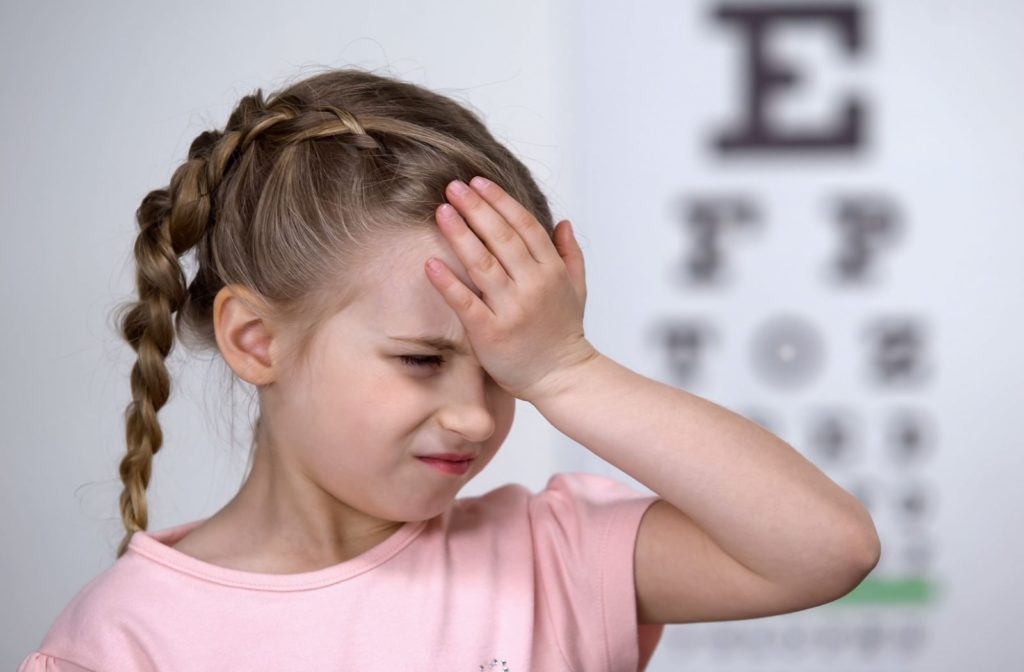Childhood is a time of many changes, and that’s the same for your child’s eyes. Eye exams can diagnose many early childhood vision issues, including myopia. Unfortunately, it’s a common condition. In fact, some research predicts that by 2050 as much as 50% of the world’s population will be myopic.
Optometrists may first diagnose myopia in children, but it doesn’t stop there. Myopia can get progressively worse as your child ages, only stabilizing when they reach adulthood. That’s why early detection is so important, as it gives you more time to slow its progression with myopia control.
What Is Myopia?
Myopia is a refractive error that affects nearly 30% of Americans. Refractive errors refer to a problem with the way light bends (or refracts) as it passes through your eyes. There are complex but precise structures all through our eyes that work together to give us a clear image.
Light first passes through the cornea at the front of the eye. The cornea bends the light into the lens, further focusing the light onto the retina at the back of the eye. The retina is a layer of photoreactive cells, so when light hits it, it will send a single up the optic nerve and to the brain. With a bit of brain power, there you have it, a clear image.
But for children with myopia, the eye has either grown too long front to back (called the axial length) or the cornea is too curved. When this happens, the light rays focus in front of the retina rather than directly on it. As a result, distant objects appear blurry while near objects remain clear. And so, it’s also referred to as nearsightedness.
Unfortunately, as children grow, so do their eyes. And they can get longer, more curved, and their myopia can worsen.

Signs of Myopia in Children
The signs of myopia are usually fairly obvious: distant objects are hard to see. But you can’t see through your child’s eyes, so how are you supposed to know? Children don’t always have the language to tell you what’s wrong. Plus, they’ve only ever known their vision; how are they supposed to know it’s not working as intended?
Kids in school could have trouble focusing because they simply can’t see the whiteboard. This inattention could be confused with learning difficulties like ADHD. Talking to your child is a great first step, but there are signs you can watch for that could indicate a vision problem:
- Discomfort, fatigue, and headaches
- Avoiding reading or holding reading materials close to eyes
- Losing place when reading
- Trouble remembering what they read
- Excessive blinking/eye rubbing
- Short attention span
- Double vision
- A turned eye
- Covering one eye or tilting their head to one side
Not all these signs indicate myopia, though they could indicate a different vision problem.
High Myopia
If myopia symptoms are allowed to progress untreated, it could become high myopia, generally any myopia with a vision prescription of -6 diopters (D) or greater. This could increase their risk of developing serious eye conditions in the future, such as:
- Glaucoma
- Cataracts
- Retinal detachment
- Macular degeneration
So, get your child’s eyes examined regularly, and we can watch for early signs. The American Optometric Association recommends kids have their first exam around 6 months and another just before they enter school. Since kids’ eyes change so much between 6 and 18, they should get an eye exam annually. Though, for adults, every 2 years is typically okay.
What is Myopia Control & Management?
We can’t reverse myopia once the damage is done. Still, with modern techniques, the ability of an eye doctor to manage and slow myopia’s progression is only getting better. Not every method will work for every child. That’s why we examine the symptoms and develop a personalized plan for myopia control.
Traditional single-lens glasses or contact lenses do an excellent job of correcting myopia to improve your vision, but they won’t slow it down. For that, you need specially designed lenses, such as the MiSight contact lenses designed for children with myopia.
These soft contact lenses use concentric rings that give your child areas of focus and defocus at the same time. They’re shaped like a bullseye. So while the lens’s center offers full myopic correction, the outer rings have a weaker prescription. Peripheral light is then focused in front of the retina, which triggers a natural mechanism telling your brain to stop axial-length eye growth.
It may sound like science fiction, but these multifocal contact lenses can signal your child’s eyes and slow myopia progression by around 43%.
MiSight is the first myopia management lens for children approved by the FDA. By focusing peripheral light in front of the retina, multifocal contact lenses naturally signal your child’s eyes to stop growing and may slow myopia by an average of 59%.
Some manufacturers have applied a similar concept to eyeglasses, using small, unfocused dots to trigger the same “stop-growing” signal.
Protect Your Child’s Eyes Today
Myopia can get worse, but there are things you can do right now that may preserve your child’s vision. 2020 Eyecare Ohio in Loveland offers modern myopia management plans with a passionate team ready to help.
If your child has been diagnosed with myopia, don’t wait! Contact us today and ask about myopia control. Let’s keep your child’s future clear together!



